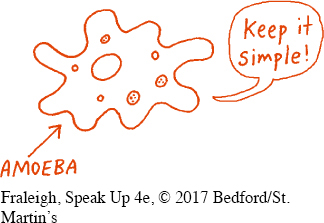Concise Language
Because audience members cannot reread or rehear portions of your speech, they have only one chance to grasp your ideas. For this reason, make sure that each of your sentences expresses just one thought. Although long sentences linking different ideas may be understandable in print, they’re hard to follow in a speech.
Page 349
As a rule of thumb, aim to be concise—that is, use the fewest words necessary to express an idea. If you are one of the millions of users of Twitter, the online social networking service, you already may be used to being succinct because tweets are limited to 140 characters; this restriction forces you to think and express yourself concisely. Giving a speech needn’t be as restrictive as writing a tweet, but a similar philosophy can be used. When you outline your speech, focus on making your points in the fewest words possible. You occasionally may want to add words or phrases to incorporate color, eloquence, wit, or humor into your talk; just make sure you have a good reason to insert those extra words.
The term for unnecessary words in a presentation is verbal clutter— extraneous words that make it hard for the audience to follow your message. Here are three examples:

“The death penalty cannot deter crime for the reason that murderers do not consider the consequences of their actions.”
“Regardless of the fact that you disagree with the government’s position, you cannot dispute the FCC’s ruling.”
“If we are to make contact with our bargaining opponents, we have to find a mutually acceptable schedule.”
You could easily revise those sentences to eliminate verbal clutter:
“The death penalty cannot deter crime because murderers do not consider the consequences of their actions.”
“Although you disagree with the government’s position, you cannot dispute the FCC’s ruling.”
“If we are to meet with our bargaining opponents, we have to find a mutually acceptable schedule.”